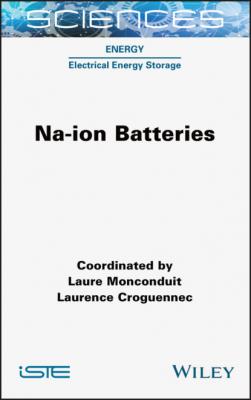ТОП просматриваемых книг сайта:
Na-ion Batteries. Laure Monconduit
Читать онлайн.Название Na-ion Batteries
Год выпуска 0
isbn 9781119818045
Автор произведения Laure Monconduit
Жанр Физика
Издательство John Wiley & Sons Limited
Na[Fe,Mn]O2 is one of the most attractive materials because of the elemental abundance of Fe and Mn in the Earth’s crust (Rudnick and Gao 2014). Also, our group reported electrode performance of O3-NaFe1/2Mn1/2O2 in a Na cell in 2012 (Yabuuchi et al. 2012a). Electronic states of Fe and Mn in O3-NaFe1/2Mn1/2O2 are HS Fe3+ (t2g3eg2) and HS Mn3+ (t2g3eg1) configurations respectively. O3-NaFe1/2Mn1/2O2 delivers a reversible capacity of 170 mAh g−1 based on Mn3+/4+ redox in a low-voltage region and Fe3+/4+ in a high-voltage region in the voltage range of 1.5–4.0 V (Figure 1.12).
Figure 1.12. Comparison of galvanostatic charge/discharge curves of layered O3 and O’3 type binary and ternary 3d transition metal oxides (left). Morphology of particles for each sample is also compared (right). Reprinted with permission from Kubota et al. (2018b). Copyright 2018, Wiley-VCH
The O3-type phase transitions into P3 and then OP2-like phases upon charge (Yabuuchi et al. 2012a), which is different from those of the end-members of O3-NaFeO2 and O’3-NaMnO2 that show only O3 and O’3 phases during charge–discharge (Kubota et al. 2018b). Partial Mn substitution for Fe in O3-NaFeO2 induces formation of a P3-type phase during charge and Mn-substitution would stabilize a P-type phase as estimated by calculations (Kim et al. 2012b). However, capacity degradation during cycles is not completely suppressed, which would be caused by migration of transition metal ions since the iron content of 50% in O3-NaFe1/2Mn1/2O2 is higher than the critical values of 33%.
1.3.2.2. O3-Na[Fe,Co,M]O2
Good effect of 3d metal coexistence is obtained for a cobalt containing material of NaFe1/2Co1/2O2. O3-NaFe1/2Co1/2O2 delivers a large reversible capacity of 160 mAh g−1 based on Co3+/4+ redox in a low-voltage region and Fe3+/4+ in a high-voltage region in the voltage range of 2.5–4.0 V (Figure 1.12) (Yoshida et al. 2013). Furthermore, relatively good cycling stability of the reversible capacities and excellent rate-capability are obtained. O3-NaFe1/2Co1/2O2 undergoes reversible 0.7 Na extraction from the structure, implying that iron migration is suppressed by coexistence with cobalt compared to O3-type Fe, Fe-Ti, and Fe-Ni systems, but further Na extraction leads to large irreversible capacity and capacity degradation (Kubota et al. 2016). Further improvement and compositional modification have been conducted for O3-NaFe1/2Co1/2O2. For examples, O3-Na[Fe1/3Co1/3Ni1/3]O2 (Vassilaras et al. 2014) and O3-Na[Fe1/4Co1/4Ni1/4Mn1/4]O2 (Li et al. 2014) deliver reversible capacities of ca. 165 and 180 mAh g−1, respectively, which are larger than 160 mAh g−1 for O3-NaFe1/2Co1/2O2. Although Ti-substitution reduces the reversible capacity, O3-Na[Fe1/4Co1/4Ni1/4Mn1/8Ti1/8]O2 delivers a reversible capacity of ca. 130 mAh g−1 in the voltage range of 2.0–4.1 V and exhibits excellent cycle stability and rate-capability (Yue et al. 2015). Optimization of the composition including the iron and cobalt contents and particle morphology is expected to further enhance the electrode performances of Na[Fe,Co,M]O2.
1.3.2.3. O3-Na[Ni,Mn,M]O2
In Na[Fe,M]O2, co-existence with Ni3+ or Mn3+ induces relatively negative effects for Na extraction/insertion. In contrast, Ni and Mn co-existence leads to enhanced electrode performance in Na cells. Our group first studied electrochemical properties of O3-NaNi1/2Mn1/2O2 in 2009 (Komaba et al. 2009). Although strong influence of the synthesis methods, Ni and Mn are not randomly distributed in the slab in which LS Ni2+ (t2g6eg2) is surrounded by HS Mn4+ (t2g3eg0) in the first coordination shell and theoretically in a zig-zag arrangement (Breger et al. 2007). O3-NaNi1/2Mn1/2O2 delivers a reversible capacity of ca. 130 mAh g−1 in a Na cell in the voltage range of 2.2–3.8 V, as shown in Figure 1.12, and ca. 200 mAh g−1 in the voltage range of 2.2–4.5 V (Komaba et al. 2012). Interestingly, relatively large discharge capacity is obtainable even after charging to the high voltage of 4.5 V corresponding to x < 0.5 in NaxNi1/2Mn1/2O2, which is different from the behaviors of O3-Na[Fe,M]O2 and single 3d transition metal systems of O3-NaTiO2, O3-NaVO2, O3-NaCrO2 and O3-NaFeO2. O3-NaMn1/2Ni1/2O2 transforms in the O3 → O’3 → P3 → P’3 → O3 sequence as Na is extracted during charge up to 4.5 V (Komaba et al. 2012; Mariyappan et al. 2018a). The P’3 → O3 transition in the charge voltage plateau region at 4.2 V versus Na involves significant shrinkage in the interslab distance (∆d00l/d00l ~18% from pristine) and is believed to cause gradual capacity fading during cycles. Furthermore, potential jumps are observed at x = 1/2 and 1/3 in NaxNi1/2Mn1/2O2 during charge and discharge, which correspond to in-plane Na/vacancy orderings in interslab space (Vinckeviciute et al. 2016). Much effort has been devoted to suppression of the interslab shrinkage and Na/vacancy ordering.
Kim et al. first reported O3-NaNi1/3Fe1/3Mn1/3O2 in 2012 (Kim et al. 2012a) and our group systematically investigated and reported Na battery performance in O3 NaNi1/2Mn1/2O2-NaFeO2 solid solution in 2013 (Yabuuchi et al. 2013). O3-Na(Ni1/2Mn1/2)1-xFexO2 (x = 0.4 and 0.6) deliver reversible capacities of ca. 140 mAh g−1 with small polarization and smooth voltage curves in the relatively narrow voltage range of 2.0–3.8 V, as shown in Figure 1.12. Wang et al. fabricated an 1 Ah soft-packed Na-ion full cell and demonstrated good cycling stability with capacity retention over 73% after 500 cycles at the 1 C rate (Wang et al. 2016). Operando XRD patterns and ex situ XAS spectra of O3-NaNi1/3Fe1/3Mn1/3O2 revealed reversible phase transitions in the O3 → P3 sequence and only the Ni2+/3+ oxidation in the range of 3.5–4.0 V and Ni3+/4+ followed by Fe3+/4+ in the range of 4.0–4.3 V during charge (Xie et al. 2016). Our group further studied effect of partial substitution of Ti for Mn in O3-NaNi0.3Fe0.4Mn0.3O2 (Komaba et al. 2014). O3-NaNi0.3Fe0.4Mn0.3-xTixO2 delivers almost the same reversible capacity of ca. 130 mAh g−1 in 2.0–3.8 V in Na cells. The average operating voltage, however, raises up with increasing Ti content, x

